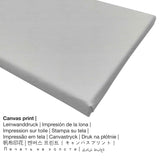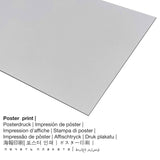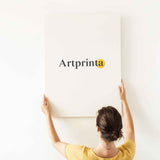George Bellows, 1913 - Cliff Dwellers - fine art print
Tax included. Shipping calculated at checkout.
Cliff Dwellers was by George Bellows. The original has the size: 40 3/16 x 42 1/16 in. Oil on canvas was applied by the American painter as the technique for the work of art. The piece of art belongs to the art collection of Los Angeles County Museum of Art. With courtesy of - Los Angeles County Museum of Art (www.lacma.org) (license: public domain).: . On top of that, alignment of the digital reproduction is square with a side ratio of 1 : 1, meaning that the length is equal to the width.
Available product material choices
We offer a range of various sizes and materials for every product. You can choose among the following product customization options:
- The poster print (canvas material): A poster print is a UV printed sheet of canvas with a slightly roughened finish on the surface, that reminds the actual work of art. A printed poster is ideally qualified for framing your art replica with a custom-made frame. Please bear in mind, that depending on the size of the poster we add a white margin 2-6cm round about the painting, which facilitates the framing with your custom frame.
- Aluminium dibond (metal print): Aluminium Dibond prints are prints on metal with an outstanding depth effect - for a modern look and a non-reflective surface structure. For your Direct Aluminium Dibond option, we print the selected artpiece onto the aluminium white-primed surface. The colors of the print are luminous, details are clear and crisp, and you can literally perceive a matte appearance of the art print surface.
- Acrylic glass print: The print on acrylic glass, which is sometimes described as a fine art print on plexiglass, will change your favorite original into wonderful décor. Your favorite artwork is made with modern UV printing machines. The special effect of this are sharp and rich colors. With a glossy acrylic glass art print contrasts and also artwork details become visible thanks to the very subtle tonal gradation. Our plexiglass with real glass coating protects your chosen art print against sunlight and heat for up to six decades.
- Canvas: The printed canvas stretched on a wooden frame. The great advantage of canvas prints is that they are relatively low in weight. This means, it is easy to hang your Canvas print without the help of any wall-mounts. Canvas prints are suited for all kinds of walls in your house.
Disclaimer: We try everything in order to depict the art products as accurate as we can and to exhibit them visually in our shop. Although, the colors of the printed materials, as well as the printing can differ slightly from the image on the monitor. Depending on the screen settings and the nature of the surface, not all colors are printed 100% realistically. Because the art prints are printed and processed by hand, there may also be minor deviations in the size and exact position of the motif.
Structured product information
| Print prodct: | art print |
| Method of reproduction: | digital reproduction |
| Manufacturing method: | UV direct print |
| Manufacturing: | made in Germany |
| Stock type: | on demand |
| Product use: | art collection (reproductions), art print gallery |
| Image alignment: | square alignment |
| Image aspect ratio: | 1 : 1 |
| Meaning: | the length is equal to the width |
| Materials available: | acrylic glass print (with real glass coating), canvas print, metal print (aluminium dibond), poster print (canvas paper) |
| Canvas on stretcher frame (canvas print) sizes: | 20x20cm - 8x8", 30x30cm - 12x12", 50x50cm - 20x20", 70x70cm - 28x28", 100x100cm - 39x39" |
| Acrylic glass print (with real glass coating) size options: | 20x20cm - 8x8", 30x30cm - 12x12", 50x50cm - 20x20", 70x70cm - 28x28", 100x100cm - 39x39" |
| Poster print (canvas paper) variants: | 30x30cm - 12x12", 50x50cm - 20x20", 70x70cm - 28x28", 100x100cm - 39x39" |
| Aluminium print (aluminium dibond material) size variants: | 20x20cm - 8x8", 30x30cm - 12x12", 50x50cm - 20x20", 70x70cm - 28x28", 100x100cm - 39x39" |
| Frame: | without frame |
Structured artwork information
| Title of the painting: | "Cliff Dwellers" |
| Artwork categorization: | painting |
| Art categorization: | modern art |
| Temporal classification: | 20th century |
| Artwork year: | 1913 |
| Artwork age: | more than 100 years old |
| Original medium of artwork: | oil on canvas |
| Original artwork size: | 40 3/16 x 42 1/16 in |
| Museum / location: | Los Angeles County Museum of Art |
| Place of museum: | Los Angeles, California, United States of America |
| Available under: | www.lacma.org |
| License type: | public domain |
| Courtesy of: | Los Angeles County Museum of Art (www.lacma.org) |
Artist details table
| Name: | George Bellows |
| Alias names: | Bellouz Dzhorzh, Bellows George Wesley, בלאוס ג'ורג', George Bellows, George Wesley Bellows, Bellows, geo. bellows, Bellows George, geo bellows |
| Gender of the artist: | male |
| Artist nationality: | American |
| Professions: | painter, lithographer |
| Home country: | United States |
| Artist classification: | modern artist |
| Age at death: | 43 years |
| Born in the year: | 1882 |
| Died: | 1925 |
This text is protected by copyright © , Artprinta (www.artprinta.com)
General specifications from Los Angeles County Museum of Art (© Copyright - by Los Angeles County Museum of Art - Los Angeles County Museum of Art)
Among the first paintings acquired by the Los Angeles County Museum of Art, Cliff Dwellers is still its best known and most often reproduced American painting.
A large part of the work’s attraction to students of American history has been the fact that it appears to stand out among Ash Can school paintings as a statement of strong social criticism. This interpretation has been derived not so much from the appearance of the canvas as from the fact that it is very similar to the drawing Why Don’t They Go to the Country for a Vacation? (1913, LACMA), executed by Bellows for the socialist journal The Masses and published as the frontispiece of its issue of August 1913.
Almost all the Ash Can school artists who contributed to The Masses stopped short of creating outright political statements. For the most part, they simply considered themselves to be realist artists, producing vignettes of urban life that fit with the journal’s alert, down-to-earth editorial tone. Their consciously artistic, realist drawings of indulgent social satire are distinctly different from the bald editorial cartooning that also appeared in The Masses. Their paintings were yet further removed from the editorial tone of the magazine. John Sloan, for instance, who occasionally contributed scathing editorial cartoons to The Masses, did not express any sense of social criticism in his paintings, which portray the energy and simple pleasures of the poor.
One cannot find in Cliff Dwellers any trace of a change in tone from Bellows’s other urban scenes, whose subject and spirit center on the excitement and bustling activity of the city and the surging vitality of its lower classes. The spirit of the scene is established by the innocent joie de vivre of the brightly lighted foreground group of young women and children, especially the bawling, grinning, brawling boys so familiar in Bellows’s works. Another prominent note is the mother ascending the stairs on the far right, so reminiscent of the hard-working homemakers of Daumier and Chardin. On the far left, the bright colors of a market cart attract the eye. Except for the large building in deep shadow, the effect is that of sunshine, with a stiff breeze lifting some of the laundry. The irregular angles of the streets and the streetcar’s "Vesey Street" destination sign suggest that this is a location in the Lower East Side of Manhattan between the Bowery and Catherine Slip below Chatam Square.
Bellows’s record book indicates that the painting was completed in May 1913. He wrote the title originally as Cliff Dwellers but then crossed out the definite article. As noted in his record book during April 1913, Bellows completed three drawings for The Masses, including the museum’s drawing reproduced in the August 1913 issue. Its title was recorded as Why Don’t They Go to the Country for a Vacation? but is also identified, in parentheses, as "(study for) Cliff Dwellers." The fact that the drawing reproduced in The Masses was completed at a time when Bellows very well may have been working on Cliff Dwellers raises the question of whether that drawing may originally have been made in preparation for the painting and then given a second life as a frontispiece in the magazine. On the other hand, the drawing is a transfer lithograph reworked with pen and ink, an uncharacteristic working method for Bellows, but one that he used for other Masses illustrations, which suggests that the drawing was done especially for the magazine. Read more (Curator Notes)














